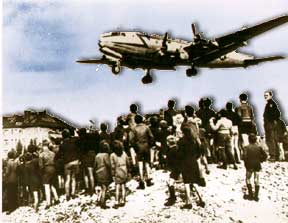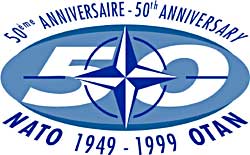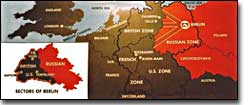52d. The Berlin Airlift and NATO

Many gather to watch a C-54 loaded with supplies land at Tempelhof airfield in the U.S. sector of Berlin. Over the 11 month course of the Airlift, nearly 4000 tons of goods were delivered every day.
Berlin, Germany's wartime capital was the prickliest of all issues that separated the United States and Soviet Union during the late 1940s. The city was divided into four zones of occupation like the rest of Germany. However, the entire city lay within the Soviet zone of occupation. Once the nation of East Germany was established, the Allied sections of the capital known as West Berlin became an island of democracy and capitalism behind the Iron Curtain.
In June 1948, tensions within Berlin touched off a crisis.
The Soviets decided to seal all land routes going into West Berlin. Stalin gambled that the Western powers were not willing to risk another war to protect half of Berlin. The Allies were tired, and their populations were unlikely to support a new war. A withdrawal by the United States would eliminate this democratic enclave in the Soviet zone.

The North Atlantic Treaty Organization celebrated an important milestone in 1999. For over 50 years now, NATO has existed as a symbol of the solidarity of Western nations.
Truman was faced with tough choices. Relinquishing Berlin to the Soviets would seriously undermine the new doctrine of containment. Any negotiated settlement would suggest that the USSR could engineer a crisis at any time to exact concessions. If Berlin were compromised, the whole of West Germany might question the American commitment to German democracy. To Harry Truman, there was no question. "We are going to stay, period, " he declared. Together, with Britain, the United States began moving massive amounts of food and supplies into West Berlin by the only path still open — the air.

Flying from occupied Germany and landing a supply plane in Berlin at the rate of one every 3 minutes, the Berlin Airlift managed to supply the city with the materials needed for survival.
Truman had thrown the gauntlet at Stalin's feet. The USSR had to now choose between war and peace. He refused to give the order to shoot down the American planes. Over the next eleven months, British and American planes flew over 4000 tons of supplies daily into West Berlin. As the American public cheered "Operation Vittles," Stalin began to look bad in the eyes of the world. He was clearly willing to use innocent civilians as pawns to quench his expansionist thirst. In May 1949, the Soviets ended the blockade. The United States and Britain had flown over 250,000-supply missions.
Stalin miscalculated when he estimated the strength of western unity. To cement the cooperation that the western allies had shown during the war and immediate postwar years, the North Atlantic Treaty Organization was created in April 1949. The pact operated on the basis of collective security. If any one of the member states were attacked, all would retaliate together. The original NATO included Britain, France, Italy, the Netherlands, Belgium, Canada, Iceland, Luxembourg, Denmark, Norway, Portugal, and the United States.
NATO was the very sort of permanent alliance George Washington warned against in his Farewell Address, and represented the first such agreement since the Franco-American Alliance that helped secure victory in the American Revolution.
The United States formally shed its isolationist past and thrust itself forward as a determined superpower fighting its new rival.






